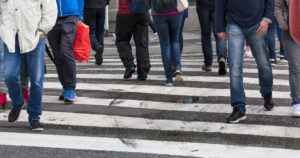National Pedestrian Safety Month
October 7, 2020 This month, the U.S. Department of Transportation (DOT) is sponsoring its first-ever National Pedestrian Safety Month. According to the Centers for Disease Control and Prevention (CDC), approximately 6,000 pedestrians are killed and another 137,000 receive emergency medical treatment for crash-related injuries every year. This National Pedestrian Safety Month take a moment to learn more about how to protect pedestrians, which the DOT calls the most “vulnerable road users.”
This month, the U.S. Department of Transportation (DOT) is sponsoring its first-ever National Pedestrian Safety Month. According to the Centers for Disease Control and Prevention (CDC), approximately 6,000 pedestrians are killed and another 137,000 receive emergency medical treatment for crash-related injuries every year. This National Pedestrian Safety Month take a moment to learn more about how to protect pedestrians, which the DOT calls the most “vulnerable road users.”
Risk Factors for Pedestrian Accidents
Traffic levels have decreased in recent months, which means that more people are opting to go out for walks instead of drives. On average, one pedestrian dies in a deadly accident every 88 minutes. The CDC reports several risk factors known to contribute to nonfatal and fatal pedestrian accidents alike, including:
- Both older adults (individuals aged 65-years-old and above) and young children under the age of 15 account for a large number of pedestrian injuries and fatalities
- Nearly half of all fatal pedestrian accidents involve an alcohol or drug impaired driver and/or pedestrian
- Visibility and geographic location. Most pedestrian fatalities occur at unmarked intersections (e.g. not at a traffic light or crosswalk), in urban areas, and at nighttime
- Speeding increases not only the chances for a pedestrian being struck by a vehicle but also the severity of the injuries he or she sustains in the crash
- Driver and pedestrian distraction, such as using a cell phone, listening to music, eating, drinking, etc.
Knowing the risk factors that contribute to fatal and serious pedestrian accidents is not enough to make a positive impact. For the month of October, the National Highway Transportation Safety Administration (NHTSA) is hosting weekly sessions on dangerous driving behaviors that endanger pedestrians. The agency will be discussing ways to improve pedestrian safety through safety tips, visualization tools, and various social media outreach campaigns. The NHTSA will also be conducting its third annual survey on Bicyclist and Pedestrian Attitudes and Behaviors. The findings from this nationwide study will be used to create effective public policies that prioritize pedestrian safety in addition to the safety of other vulnerable road users.
Safety Tips
Drivers and pedestrians can both take precautions to help others stay safe on the roads. Pedestrians who are out walking at night or in heavily trafficked areas should increase their visibility by wearing bright or reflective clothing. Pedestrians should cross at designated crossings or intersections whenever it is possible. If a sidewalk or path is not available, pedestrians should walk on the shoulder facing oncoming traffic. Another precaution that pedestrians (and drivers) can take is to avoid distractions like the use of electronic devices or earbuds, which can increase the chance of a collision happening.
Drivers should always keep an eye out for pedestrians – but they should be particularly mindful in dense urban areas, near parks, and in school zones. Drivers should also prepare to slow down or come to a complete stop near crosswalks and at traffic lights. Some other ways that drivers can do their part to keep pedestrians safe include:
- Obeying posted speed limits and other traffic signs and signals
- Yielding to pedestrians, even if they are jaywalking or unexpectedly crossing the street
- Never passing a stopped school bus. In fact, drivers should always be cautious and prepared to stop around any stopped vehicle
- If the weather is inclement, exert extra caution. For example, make sure to have your headlights on so pedestrians can see your vehicle and use turning signals. Before making a turn, double check that no one is crossing at either intersection
- Checking your rearview mirror and side mirrors before you back up
- Commit to never getting behind the wheel if you are impaired by alcohol and/or drugs
If you were injured in an accident and have questions about filing a legal claim, someone at our firm can help. Contact a representative online now.
Philadelphia Personal Injury Lawyers at Galfand Berger, LLP Representing Injured Victims Since 1947
Galfand Berger has offices located in Philadelphia, Bethlehem, Lancaster, and Reading, we serve clients throughout Pennsylvania and New Jersey. To schedule a consultation, call us at 800-222-8792 or complete our online contact form.
 Google Screened
Google Screened
